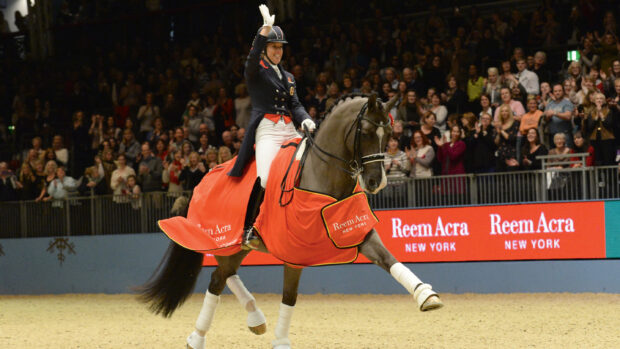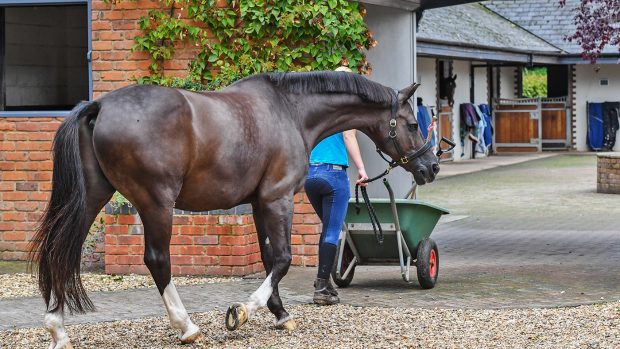Among the many responsibilities Alan Davies has had as a groom, flying horses around the world has become one of his specialist areas of expertise. In fact Alan, who will this year step back from his role as full-time groom to Charlotte Dujardin and Carl Hester, estimates that he has been flying horses for about 30 years.
Things have changed somewhat in that time.
“My first flight was out to New York with some showjumpers and in those times we used to load them into the plane and build crates around them,” revealed Alan, on episode 18 of The Horse & Hound Podcast. “We could also have any number of people on the plane, sitting anywhere. I remember sleeping with the horses under a Witney blanket going to and from America.”
Now though, horse flights take a limited number of people, usually nine, with everyone being required to stay seated with a seatbelt on during takeoff and landing, and to carry oxygen masks in case of an emergency.
The restrictions on numbers mean that grooms often take responsibility for several horses on a flight, with Alan taking charge of all the British team horses when flying out to Tokyo for the Olympics in 2021, and before that the USA for the World Equestrian Games in 2018.
What does flying horses on planes involve?
So what does flying horses actually involve?
“The whole procedure starts from home, and I usually leave the day before to drive the horses to Liege in Belgium, where the flights leave from,” explains Alan. “They have really nice stabling there so we arrive the night before and I give the horses a walk when we get there.
“They bring the crates – which basically look like two-horse trailers – to the loading bay, which is a massive room that is padded and matted to make it safe for the horses. There’s a complex schedule for which horses go with which others in the crates, and the guys from the shipping agency go round talking to the grooms about it.
“The horses get loaded into the crates from the loading bay, then the ramps get put up, three crates are linked together and they get towed by a tractor out onto the tarmac,” continues Alan. “It can be quite noisy, with rattling crates and other planes coming in, so sometimes I plug their ears, or put ear covers on.
“Then they are pushed onto a hydraulic lift, which lifts them up the side of the plane, and pushed along some runners into the plane. The whole thing is quite a feat really, and can take four to five hours.”
Alan Davies: ‘Flying horses involves a lot of camaraderie’
Once on board the plane, Alan says that flying is actually quite a peaceful experience, explaining that all the grooms, vets and riders travelling work together to help keep all the horses on board happy and safe.
“There’s real camaraderie on flights,” he says.
“Up in the air, it’s quite peaceful, and usually there’s air con. There’s not much space in the crates, so I usually take a spare headcollar and rope, a bit of feed, a canister of water and lots of carrots and apples. The other equipment goes in trunks below.”

L-R: Valegro settling into a flight, Alan with Mount St John Freestyle en route to the 2018 World Equestrian Games, Valegro leaving for the World Cup Final in Las Vegas 2015
Alan has flown with many horses over his long career, and explains that they all react quite differently to the experience, while generally coping very well.
“It’s amazing how well horses cope with it all – they’re such amazing creatures, with the things we ask them to do.
“When we flew to Tryon in 2018, I was worried about Hawtins Delicato, but he put himself in the crate with his head in the corner and once I hung up a haynet he was fine. But Mount St John Freestyle was a nosy madam, a right curtain switcher and she was always trying to look out. She got a right shock when she saw the planes on the tarmac – her eyes were out on stalks.
“It was always something I loved about Valegro – he trusted me implicitly to take him around the world,” adds Alan. “We travelled around 75,000km together. I had to take him on different trucks and boats and trains and planes, and he just trusted me every time, following me into the crates at the airport and never questioning that he was going to be fine.
“Valegro actually used to love flying. It was just me and him and we’d be off on an adventure and he got to eat lots. Especially on the long flight to Rio for the Olympics in 2016, I’m sure he was thinking, ‘Daddy’s here, with a bag of carrots – this is the life’.”
You might also be interested in:

‘I have half the British team on my lorry – get out the way!’: Groom Alan Davies on prepping for an Olympics

Precious cargo: horses fly ‘business class’ to the Tokyo Olympics

‘I sobbed all the way up the centre line’: Alan Davies’ highlights from his time as Valegro’s super-groom

Carl Hester: ‘Our legendary groom Alan Davies may be stepping back, but I’m not…’

‘I’m putting my brave pants on!’ – super groom Alan Davies checks in from pre-Olympic quarantine

Subscribe to Horse & Hound magazine today – and enjoy unlimited website access all year round
Horse & Hound magazine, out every Thursday, is packed with all the latest news and reports, as well as interviews, specials, nostalgia, vet and training advice. Find how you can enjoy the magazine delivered to your door every week, plus options to upgrade your subscription to access our online service that brings you breaking news and reports as well as other benefits.




